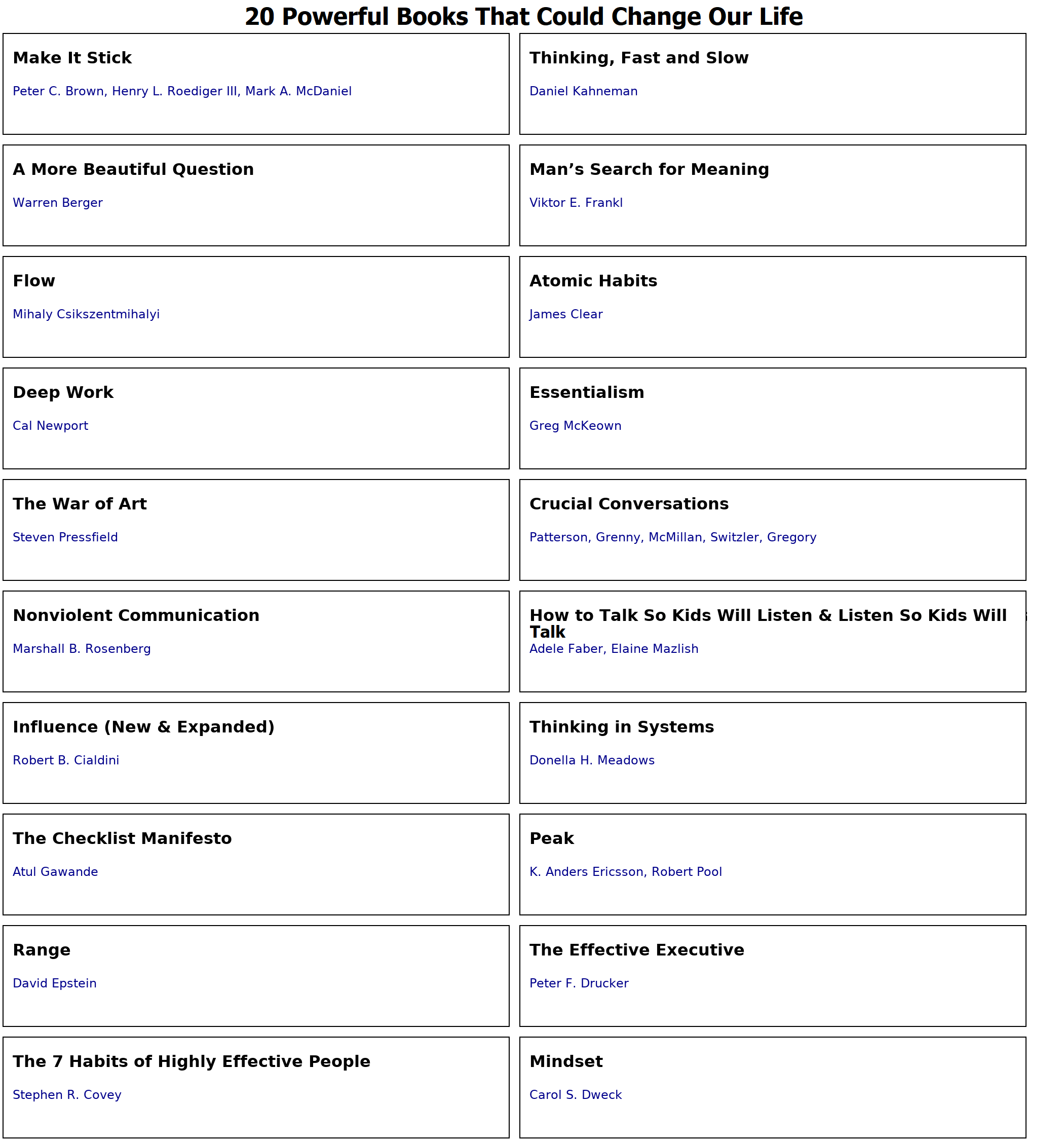
20 Powerful Books That Could Change Our Life
Books shape what we notice, how we think, and what we do next.
Decades of learning science show that certain practices—retrieval practice, spacing, and elaboration—dramatically improve retention and transfer. That is why several titles below teach how to learn, not only what to learn.
Habits and systems determine whether insight turns into behavior. Habit formation can take weeks to months, and checklists have reduced human error in complex settings like surgery. Books that translate such evidence into daily routines tend to produce durable change.
Focus and attention are scarce. Heavy media multitasking correlates with poorer distractor filtering and task-switching performance. Designing periods of deep work helps you learn complex things faster.
Mindset and motivation matter, and nuance matters too. Growth-mindset interventions can help, particularly for some learners, yet effects vary by context. Credible reading balances optimism with evidence.
Table of Content
- 20 Powerful Books That Could Change Our Life
- How to Use This Guide (Evidence-Based Reading Method)
- The 20 Books (Grouped by Life Skill)
- Starter Reading Paths (By Persona)
- Practical Tools: How to Read for Change
- Conclusion
- FAQs
How to Use This Guide (Evidence-Based Reading Method)
Read with goals. Define a specific skill or problem each book should help you solve.
Use retrieval. After each chapter, close the book and write what you remember. Testing yourself beats rereading.
Space it out. Re-visit notes weekly rather than cramming.
Elaborate with questions. Ask “Why would this work in my life? When wouldn’t it?” Elaborative interrogation and self-explanation improve learning.
Build a tiny experiment from each book. One behavior, one metric, one week.
Protect attention. Schedule 60–90 minute focus blocks and keep devices out of reach.
The 20 Books (Grouped by Life Skill)

Learn & Think Better
Make It Stick: The Science of Successful Learning — Peter C. Brown, Henry L. Roediger III, Mark A. McDaniel
Why it helps: Turns robust cognitive science into practical study techniques—retrieval practice, spaced repetition, interleaving, and varied practice—shown to boost long-term retention and transfer. The authors dismantle common myths like “re-reading equals learning.”
Try this: After each section, write three questions you expect the test or life to ask. Answer them from memory, then check and correct.
Thinking, Fast and Slow — Daniel Kahneman
Why it helps: Explains the two modes of thinking, common biases like anchoring and availability, and how to design decisions with premortems and outside views. The official publisher page is a reliable overview.
Try this: Before big choices, write your outside view with base rates, similar cases, and a one-paragraph premortem.
A More Beautiful Question — Warren Berger
Why it helps: Re-builds the habit of inquiry at work and home. Pairs well with research on elaborative interrogation and self-explanation, both linked to better understanding.
Try this: Keep a weekly Q-list. Why does X persist? What if Y? How might we solve Z? Choose one question to prototype each Friday.
Find Meaning & Motivation
Man’s Search for Meaning — Viktor E. Frankl
Why it helps: A humane framework for purpose through responsibility, relationships, and attitude. The canonical edition remains widely read for good reason.
Try this: Use the “responsibleness” test. Given my constraints, what small, meaningful task is mine to do today? Record one sentence each night.
Flow — Mihaly Csikszentmihalyi
Why it helps: Describes optimal experience when challenge meets skill and attention fully engages. Clear goals and feedback make life more absorbing.
Try this: For one key task, set a clear goal, remove distractions for 60 minutes, and raise the challenge slightly above your current skill.
Build Habits & Focus
Atomic Habits — James Clear
Why it helps: A pragmatic system for behavioral change—cue, craving, response, reward—consistent with experimental work showing habit formation is gradual. Pair habit stacking with realistic timelines.
Try this: Choose one keystone habit such as a 10-minute walk after lunch. Track it for 30–90 days and expect variability.
Deep Work — Cal Newport
Why it helps: Argues for long, uninterrupted focus blocks to learn complex things quickly and produce higher-quality work. The publisher summary outlines rules and examples.
Try this: Book two 90-minute sessions per week for your hardest skill. Keep the phone in another room and ship one small increment.
Essentialism — Greg McKeown
Why it helps: Filters the trivial many from the vital few so you can say a truthful no. Useful for reducing cognitive load and protecting time for deep work.
Try this: Conduct a weekly essential intent review. If a task does not advance your one essential intent, postpone or delegate.
The War of Art — Steven Pressfield
Why it helps: Names the inner force that blocks creative work and outlines routines to move anyway. A concise companion to Deep Work.
Try this: Use the two-page rule. Write two pages every weekday before checking messages.
Communicate & Relate
Crucial Conversations — Patterson, Grenny, McMillan, Switzler, Gregory
Why it helps: Tools for high-stakes dialogues—how to create psychological safety, state facts, and invite mutual purpose. The official site provides summaries and resources.
Try this: Start tough talks with CPR. Content for today’s issue, Pattern for recurring issues, Relationship for trust impact. Clarify which you are addressing.
Nonviolent Communication — Marshall B. Rosenberg
Why it helps: A four-part skill—observations, feelings, needs, requests—grounded in empathy. Widely used in teams, schools, and families.
Try this: Translate one complaint into an observable description plus a doable request.
How to Talk So Kids Will Listen & Listen So Kids Will Talk — Adele Faber and Elaine Mazlish
Why it helps: Practical scripts for emotion coaching and collaborative problem-solving with children. Applies to adults more than you might think.
Try this: When emotions run high, name the feeling and give fantasy. You wish bedtime could start at midnight.
Decide & Design Systems
Influence (New & Expanded) — Robert B. Cialdini
Why it helps: The classic on the psychology of persuasion with guidance for ethical defense. Principles include reciprocity, commitment, social proof, authority, liking, and scarcity with updates.
Try this: Audit one message you plan to send. Identify which principle it uses and add an ethical proof element.
Thinking in Systems — Donella H. Meadows
Why it helps: Teaches feedback loops, stocks and flows, and leverage points. Shows how to see the system behind recurring problems.
Try this: For any stubborn problem, map inputs, activities, outputs, and outcomes. Highlight reinforcing and balancing loops.
The Checklist Manifesto — Atul Gawande
Why it helps: Shows how well-designed checklists reduce errors in complex work. A multicountry study linked adoption to lower complications and mortality.
Try this: Build a 5–9 item start-up or close-down checklist for your most error-prone process.
Mastery, Career & Leadership
Peak — K. Anders Ericsson and Robert Pool
Why it helps: Explains deliberate practice—goal-directed, feedback-rich, mentally demanding practice that builds expert performance. Complements Deep Work.
Try this: Define one practice zone task per week with clear feedback and a coach or accountability partner.
Range — David Epstein
Why it helps: Argues for breadth, sampling, and analogical thinking as engines for problem-solving. A counterweight to early hyper-specialization.
Try this: Do a skill cross-over. Borrow a tool from an unrelated field to solve today’s problem.
The Effective Executive — Peter F. Drucker
Why it helps: Classic lessons on time audits, strengths-based contribution, and decision hygiene for leaders and individual contributors.
Try this: Run a two-week time log. Kill or compress the bottom ten percent of low-value activities.
The 7 Habits of Highly Effective People — Stephen R. Covey
Why it helps: A principled framework that integrates personal leadership and interpersonal effectiveness. Habits build from independence to interdependence.
Try this: Write a one-page roles and goals weekly plan. List roles at the top and one outcome per role.
Mindset & Growth
Mindset — Carol S. Dweck
Why it helps: Distinguishes fixed versus growth beliefs about ability and translates them into coaching language using yet and process feedback. Read with nuance on context-specific effects.
Try this: When giving feedback, praise strategy, effort, and seeking help, not just outcomes.
Starter Reading Paths (By Persona)
Students and lifelong learners: Make It Stick, Deep Work, Mindset, A More Beautiful Question. Use retrieval, spaced review, and weekly Q-lists.
Managers and team leads: The Effective Executive, Crucial Conversations, Influence, Thinking in Systems. Run time audits, build two checklists, and map one system.
Creators and knowledge workers: Deep Work, The War of Art, Essentialism, Range. Book two daily focus blocks and ship one creative increment each week.
Parents and educators: How to Talk So Kids Will Listen, Nonviolent Communication, Mindset, Make It Stick. Practice emotion labeling and retrieval-based study.
Practical Tools: How to Read for Change
Retrieval Routine (10 minutes)
After each reading session, write three bullet summaries from memory and one Why or How question. Answer it tomorrow. This combines retrieval, elaboration, and spacing.
Premortem for Big Decisions (15 minutes)
Before acting on a book’s idea, imagine it failed six months from now. List reasons and adjust the plan.
Focus Block Protocol (60–90 minutes)
Choose a single task, define a clear goal, silence notifications, and keep the phone outside the room. Protect attention and measure output.
Habit Timeline
Expect a few weeks to a few months to automate a new behavior. Track streaks and prioritize consistency over perfection.
Conclusion
A single book rarely changes a life. A practice built from books often does.
Choose three titles that match your current problem. Read them with retrieval and spacing. Run one small experiment from each. Protect your attention while you do it.
You will remember more, decide better, and steadily change who you become.
FAQs
What’s the best place to start if I’m overwhelmed?
Pick one goal such as learn faster or fix tough conversations. Choose one book from that skill cluster and run a seven-day experiment drawn from its first two chapters.
How many books should I read at once?
One for action and one for curiosity. Keep the action book tied to a weekly behavior you can measure such as minutes practiced, conversations held, or pages written.
Do audiobooks work as well as print?
They are excellent for first exposure. For durable learning, add retrieval by pausing to recall and write a short summary the same day.
How long until a book-inspired habit sticks?
Expect weeks to months. Track consistency and forgive misses. Then resume.
How do I avoid inspiration without action?
Make a one-page Book to Behavior plan that lists the problem, one behavior, a trigger, a seven-day metric, and a short weekly review. Pair that with a premortem before big bets.
Must Read Books

